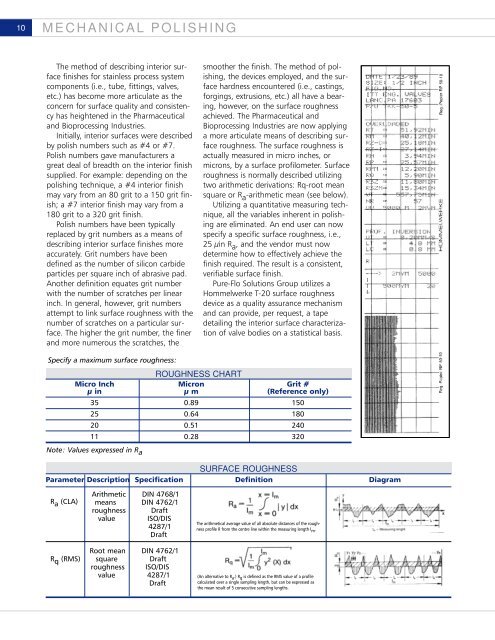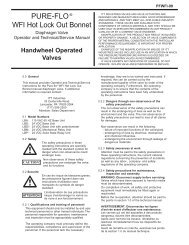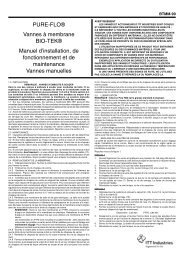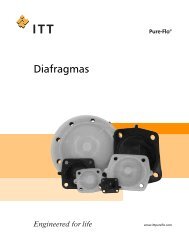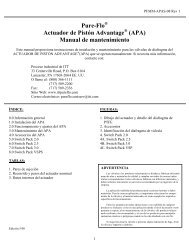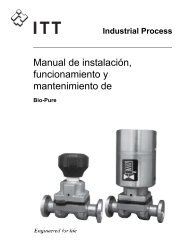You also want an ePaper? Increase the reach of your titles
YUMPU automatically turns print PDFs into web optimized ePapers that Google loves.
10 MECHANICAL POLISHING<br />
The method of describing interior surface<br />
finishes for stainless process system<br />
components (i.e., tube, fittings, valves,<br />
etc.) has become more articulate as the<br />
concern for surface quality and consistency<br />
has heightened in the Pharmaceutical<br />
and Bioprocessing Industries.<br />
Initially, interior surfaces were described<br />
by polish numbers such as #4 or #7.<br />
Polish numbers gave manufacturers a<br />
great deal of breadth on the interior finish<br />
supplied. For example: depending on the<br />
polishing technique, a #4 interior finish<br />
may vary from an 80 grit to a 150 grit finish;<br />
a #7 interior finish may vary from a<br />
180 grit to a 320 grit finish.<br />
Polish numbers have been typically<br />
replaced by grit numbers as a means of<br />
describing interior surface finishes more<br />
accurately. Grit numbers have been<br />
defined as the number of silicon carbide<br />
particles per square inch of abrasive pad.<br />
Another definition equates grit number<br />
with the number of scratches per linear<br />
inch. In general, however, grit numbers<br />
attempt to link surface roughness with the<br />
number of scratches on a particular surface.<br />
The higher the grit number, the finer<br />
and more numerous the scratches, the<br />
Specify a maximum surface roughness:<br />
SURFACE ROUGHNESS<br />
Parameter Description Specification Definition Diagram<br />
R a (CLA)<br />
R q (RMS)<br />
Arithmetic DIN 4768/1<br />
means DIN 4762/1<br />
roughness Draft<br />
value ISO/DIS<br />
4287/1<br />
Draft<br />
Root mean DIN 4762/1<br />
square Draft<br />
roughness ISO/DIS<br />
value 4287/1<br />
Draft<br />
smoother the finish. The method of polishing,<br />
the devices employed, and the surface<br />
hardness encountered (i.e., castings,<br />
forgings, extrusions, etc.) all have a bearing,<br />
however, on the surface roughness<br />
achieved. The Pharmaceutical and<br />
Bioprocessing Industries are now applying<br />
a more articulate means of describing surface<br />
roughness. The surface roughness is<br />
actually measured in micro inches, or<br />
microns, by a surface profilometer. Surface<br />
roughness is normally described utilizing<br />
two arithmetic derivations: Rq-root mean<br />
square or R a -arithmetic mean (see below).<br />
Utilizing a quantitative measuring technique,<br />
all the variables inherent in polishing<br />
are eliminated. An end user can now<br />
specify a specific surface roughness, i.e.,<br />
25 µin R a , and the vendor must now<br />
determine how to effectively achieve the<br />
finish required. The result is a consistent,<br />
verifiable surface finish.<br />
<strong>Pure</strong>-Flo Solutions Group utilizes a<br />
Hommelwerke T-20 surface roughness<br />
device as a quality assurance mechanism<br />
and can provide, per request, a tape<br />
detailing the interior surface characterization<br />
of valve bodies on a statistical basis.<br />
ROUGHNESS CHART<br />
Micro Inch Micron Grit #<br />
µ in µ m (Reference only)<br />
35 0.89 150<br />
25 0.64 180<br />
20 0.51 240<br />
11 0.28 320<br />
Note: Values expressed in R a<br />
The arithmetical average value of all absolute distances of the roughness<br />
profile R from the centre line within the measuring length l m .<br />
(An alternative to R a .) R q is defined as the RMS value of a profile<br />
calculated over a single sampling length, but can be expressed as<br />
the mean result of 5 consecutive sampling lengths.


